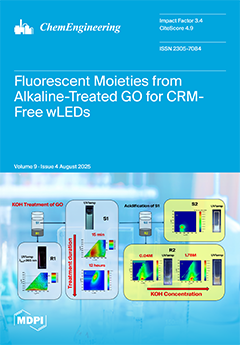This study proposes considering the effective re–benefication of coal middlings and other such considered waste materials as a way to ensure that clean coal in coal by–products can be extracted and effectively utilized, saving costs and reducing coal waste. To quantify the clean–coal
[...] Read more.
This study proposes considering the effective re–benefication of coal middlings and other such considered waste materials as a way to ensure that clean coal in coal by–products can be extracted and effectively utilized, saving costs and reducing coal waste. To quantify the clean–coal yield and ash reduction that can be achieved by re–beneficiating four typical by–product streams from the Guobei Coal Preparation Plant (6 Mt a
−1) were used for the study. Coking–coal middlings, flotation tailings, and pressure–filter cakes from preparation plants still contain 30–60% combustible matter. Re–beneficiation techniques have been considered to recover this often-wasted coal, reduce waste rock disposal, and cut greenhouse–gas emissions per ton of clean coal produced. Representative samples (
n = 4) were collected, sample size–classified as (fine coal particles ≤0.5 mm and coarse particles ≥) and subjected to (i) magnetite removal, (ii) laboratory froth flotation (diesel 507 g t
−1, sec–octanol 103 g t
−1), and (iii) fine and large particle density separation at 1.3–1.8 g cm
−3 ZnCO
3 media. Clean–coal yield and ash were measured for each stream and the coal’s particle liberation was examined by SEM. Crushing, grinding and liberation equipment and techniques that aid in the treatment of coal and the re–beneficiation of coal middlings and tailings. The key findings recorded during the experiment are as follows: Flotation of <0.5 mm fractions delivered 46.9–58.3% clean–coal yield at 10.3–17.0% ash. Density separation of 0.5–1.0 mm middlings peaked at 1.4–1.5 g cm
−3, yielding 34.2% clean coal at 15–18.4% ash. Scanning Electron Microscope analysis confirmed partial liberation as results from re–grinding + second flotation which increased yield by a further 8–12%. A calculated theoretical examination of the preliminary cost–benefit analysis indicates ≈36 CNY t
−1≈9 million CNY a
−1 in saved disposal costs alone. savings in disposal and 0.25 Mt a
−1 additional clean coal for the Guobei plant. The research presented in this paper highlights the current work by Anhui University of Science and technology in collaboration with Guobei coal preparation plant and the results therein achieved.
Full article





